engine coolant YAMAHA YZF-R6 2014 Owners Manual
[x] Cancel search | Manufacturer: YAMAHA, Model Year: 2014, Model line: YZF-R6, Model: YAMAHA YZF-R6 2014Pages: 112, PDF Size: 2.52 MB
Page 6 of 112

TABLE OF CONTENTSSAFETY INFORMATION.................. 1-1
DESCRIPTION .................................. 2-1
Left view ......................................... 2-1
Right view ....................................... 2-2
Controls and instruments ............... 2-3
INSTRUMENT AND CONTROL
FUNCTIONS ...................................... 3-1
Immobilizer system......................... 3-1
Main switch/steering lock............... 3-2
Indicator lights and warning lights............................................ 3-4
Multi-function meter unit ................ 3-8
Handlebar switches ...................... 3-14
Clutch lever .................................. 3-15
Shift pedal .................................... 3-15
Brake lever.................................... 3-16
Brake pedal .................................. 3-16
Fuel tank cap ................................ 3-17
Fuel ............................................... 3-17
Fuel tank breather hose and overflow hose ............................ 3-19
Catalytic converters...................... 3-19
Seats ............................................ 3-20
Helmet holding cable.................... 3-21
Rear view mirrors.......................... 3-22
Adjusting the front fork ................. 3-22
Adjusting the shock absorber assembly ................................... 3-24
Luggage strap holders ................. 3-27 EXUP system ................................ 3-27
Sidestand ...................................... 3-28
Ignition circuit cut-off system ....... 3-28
FOR YOUR SAFETY –
PRE-OPERATION CHECKS ............. 4-1
OPERATION AND IMPORTANT
RIDING POINTS ................................ 5-1
Starting the engine .......................... 5-1
Shifting ............................................ 5-2
Tips for reducing fuel consumption ................................ 5-3
Engine break-in ............................... 5-3
Parking ............................................ 5-4
PERIODIC MAINTENANCE AND
ADJUSTMENT ................................... 6-1
Owner’s tool kit ............................... 6-2
Periodic maintenance chart for the emission control system .............. 6-3
General maintenance and lubrication chart ........................... 6-4
Removing and installing cowlings and panels ................................... 6-8
Checking the spark plugs ............. 6-12
Engine oil and oil filter cartridge.... 6-13
Coolant.......................................... 6-16
Air filter element ............................ 6-19
Checking the engine idling
speed ......................................... 6-19 Checking the throttle grip free
play ............................................ 6-20
Valve clearance............................. 6-20
Tires .............................................. 6-20
Cast wheels .................................. 6-23
Adjusting the clutch lever free play ............................................ 6-23
Checking the brake lever free
play ............................................ 6-24
Brake light switches ..................... 6-25
Checking the front and rear brake pads .......................................... 6-25
Checking the brake fluid level ...... 6-26
Changing the brake fluid .............. 6-27
Drive chain slack........................... 6-27
Cleaning and lubricating the drive chain.......................................... 6-29
Checking and lubricating the cables ........................................ 6-30
Checking and lubricating the
throttle grip and cable ............... 6-30
Checking and lubricating the brake and shift pedals............... 6-30
Checking and lubricating the brake and clutch levers ............. 6-31
Checking and lubricating the
sidestand................................... 6-32
Lubricating the swingarm pivots......................................... 6-32
Checking the front fork ................. 6-32
Checking the steering................... 6-33U2CXE0E0.book Page 1 Monday, July 29, 2013 2:02 PM
Page 14 of 112
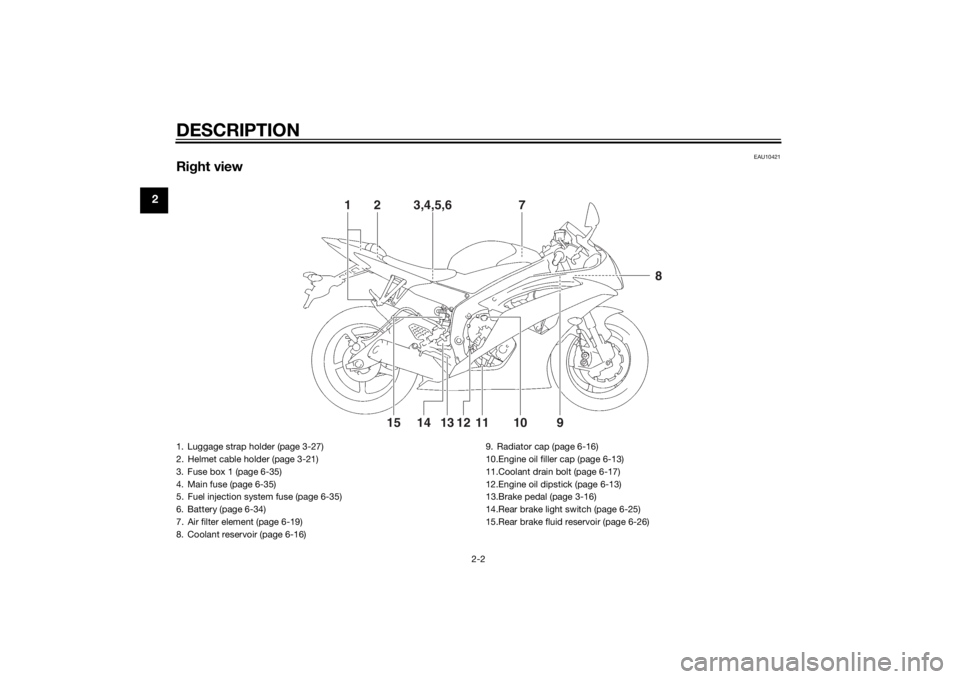
DESCRIPTION
2-2
2
EAU10421
Right view
1
2
3,4,5,6
710
9
8
11
12
13
14
15
1. Luggage strap holder (page 3-27)
2. Helmet cable holder (page 3-21)
3. Fuse box 1 (page 6-35)
4. Main fuse (page 6-35)
5. Fuel injection system fuse (page 6-35)
6. Battery (page 6-34)
7. Air filter element (page 6-19)
8. Coolant reservoir (page 6-16) 9. Radiator cap (page 6-16)
10.Engine oil filler cap (page 6-13)
11.Coolant drain bolt (page 6-17)
12.Engine oil dipstick (page 6-13)
13.Brake pedal (page 3-16)
14.Rear brake light switch (page 6-25)
15.Rear brake fluid reservoir (page 6-26)U2CXE0E0.book Page 2 Monday, July 29, 2013 2:02 PM
Page 19 of 112
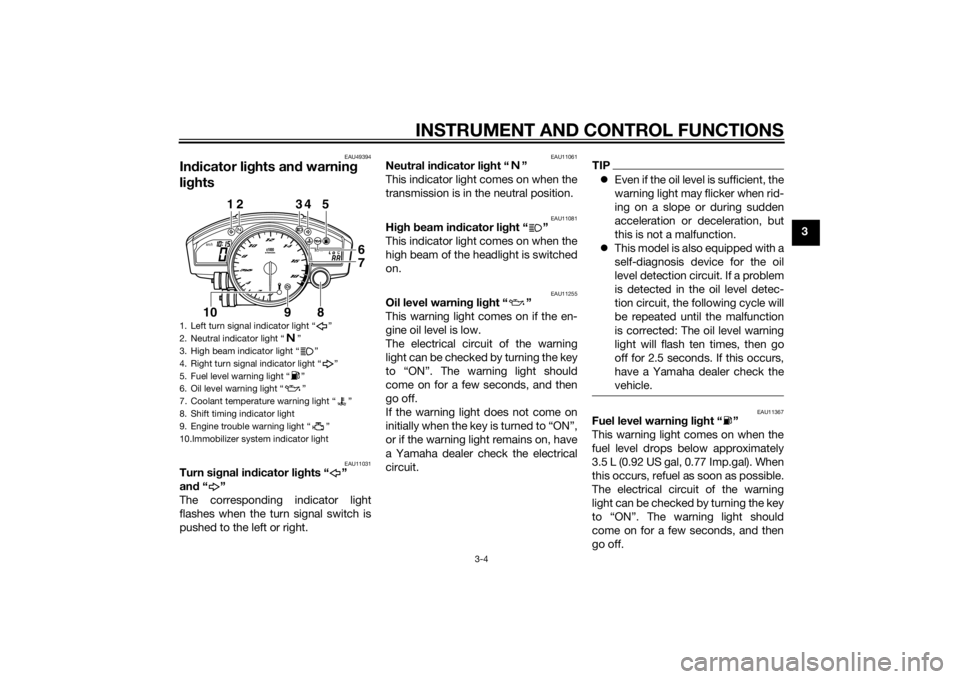
INSTRUMENT AND CONTROL FUNCTIONS
3-4
3
EAU49394
Indicator lig hts and warning
lig hts
EAU11031
Turn si gnal in dicator li ghts “ ”
an d“”
The corresponding indicator light
flashes when the turn signal switch is
pushed to the left or right.
EAU11061
Neutral in dicator li ght “ ”
This indicator light comes on when the
transmission is in the neutral position.
EAU11081
Hi gh beam in dicator li ght “ ”
This indicator light comes on when the
high beam of the headlight is switched
on.
EAU11255
Oil level warnin g lig ht “ ”
This warning light comes on if the en-
gine oil level is low.
The electrical circuit of the warning
light can be checked by turning the key
to “ON”. The warning light should
come on for a few seconds, and then
go off.
If the warning light does not come on
initially when the key is turned to “ON”,
or if the warning light remains on, have
a Yamaha dealer check the electrical
circuit.
TIP Even if the oil level is sufficient, the
warning light may flicker when rid-
ing on a slope or during sudden
acceleration or deceleration, but
this is not a malfunction.
This model is also equipped with a
self-diagnosis device for the oil
level detection circuit. If a problem
is detected in the oil level detec-
tion circuit, the following cycle will
be repeated until the malfunction
is corrected: The oil level warning
light will flash ten times, then go
off for 2.5 seconds. If this occurs,
have a Yamaha dealer check the
vehicle.
EAU11367
Fuel level warnin g li ght “ ”
This warning light comes on when the
fuel level drops below approximately
3.5 L (0.92 US gal, 0.77 Imp.gal). When
this occurs, refuel as soon as possible.
The electrical circuit of the warning
light can be checked by turning the key
to “ON”. The warning light should
come on for a few seconds, and then
go off.
1. Left turn signal indicator light “ ”
2. Neutral indicator light “ ”
3. High beam indicator light “ ”
4. Right turn signal indicator light “ ”
5. Fuel level warning light “ ”
6. Oil level warning light “ ”
7. Coolant temperature warning light “ ”
8. Shift timing indicator light
9. Engine trouble warning light “ ”
10.Immobilizer system indicator light
km/h
TRIP A
˚C
12 34 5
6
7
8
9
10
U2CXE0E0.book Page 4 Monday, July 29, 2013 2:02 PM
Page 20 of 112
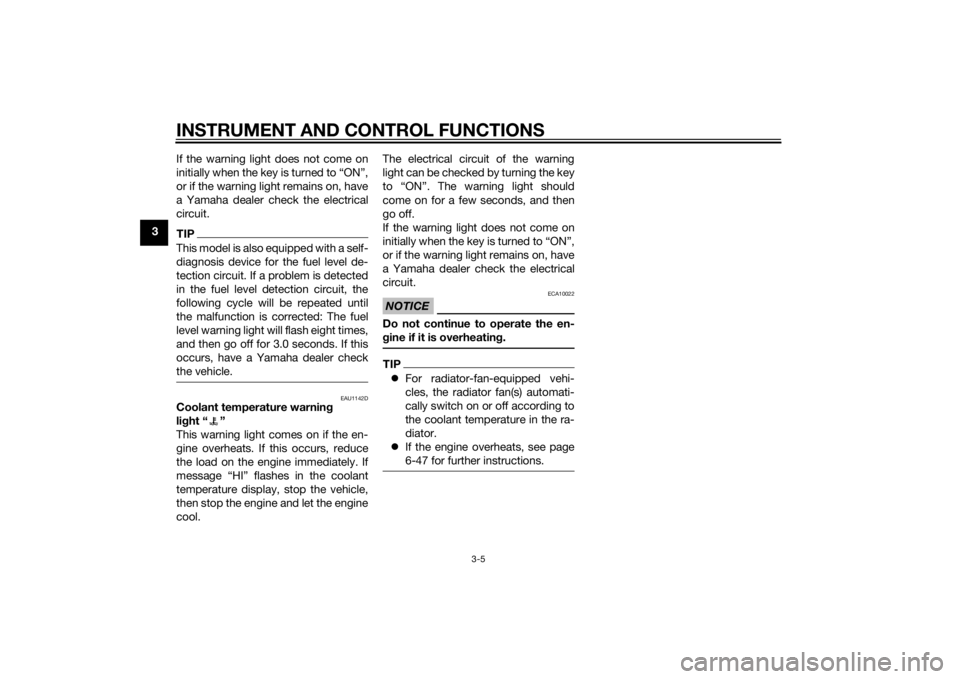
INSTRUMENT AND CONTROL FUNCTIONS
3-5
3If the warning light does not come on
initially when the key is turned to “ON”,
or if the warning light remains on, have
a Yamaha dealer check the electrical
circuit.
TIPThis model is also equipped with a self-
diagnosis device for the fuel level de-
tection circuit. If a problem is detected
in the fuel level detection circuit, the
following cycle will be repeated until
the malfunction is corrected: The fuel
level warning light will flash eight times,
and then go off for 3.0 seconds. If this
occurs, have a Yamaha dealer check
the vehicle.
EAU1142D
Coolant temperature warnin
g
li g ht “ ”
This warning light comes on if the en-
gine overheats. If this occurs, reduce
the load on the engine immediately. If
message “HI” flashes in the coolant
temperature display, stop the vehicle,
then stop the engine and let the engine
cool. The electrical circuit of the warning
light can be checked by turning the key
to “ON”. The warning light should
come on for a few seconds, and then
go off.
If the warning light does not come on
initially when the key is turned to “ON”,
or if the warning light remains on, have
a Yamaha dealer check the electrical
circuit.
NOTICE
ECA10022
Do not continue to operate the en-
g
ine if it is overheatin g.TIP For radiator-fan-equipped vehi-
cles, the radiator fan(s) automati-
cally switch on or off according to
the coolant temperature in the ra-
diator.
If the engine overheats, see page
6-47 for further instructions.
U2CXE0E0.book Page 5 Monday, July 29, 2013 2:02 PM
Page 21 of 112

INSTRUMENT AND CONTROL FUNCTIONS
3-6
3
DisplayConditions What to do
Under 40 °C
(Under 104 °F) Message “Lo” is displayed. OK. Go ahead with riding.
40–116 °C
(104–242 °F) Coolant temperature is dis-
played.
OK. Go ahead with riding.
117–134 °C
(243–274 °F) Coolant temperature flash-
es.
Warning light comes on.Reduce the load on the engine by riding
at a moderate pace, at low rpm, until
the coolant temperature goes down.
If the temperature does not go down,
stop the engine. (See page 6-47.)
Above 134 °C
(Above 274 °F) Message “HI” flashes.
Warning light is on.Stop the engine and allow it to cool.
(See page 6-47.)
TRIP A
˚C
TRIP A
˚C
TRIP A
˚C
TRIP A
˚C
U2CXE0E0.book Page 6 Monday, July 29, 2013 2:02 PM
Page 23 of 112
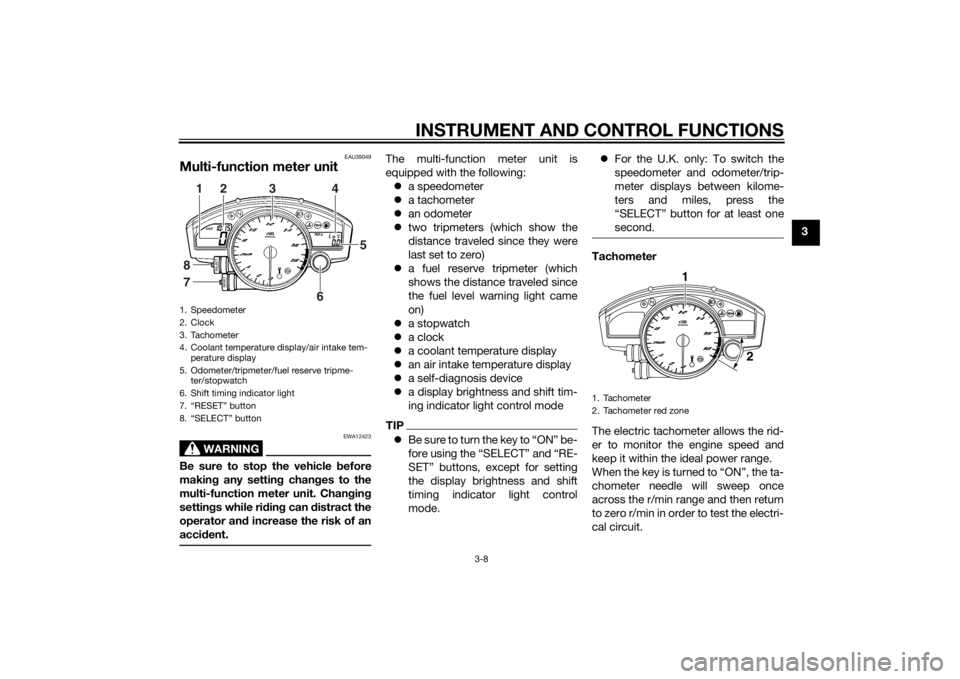
INSTRUMENT AND CONTROL FUNCTIONS
3-8
3
EAU39049
Multi-function meter unit
WARNING
EWA12423
Be sure to stop the vehicle before
makin g any settin g chan ges to the
multi-function meter unit. Chan gin g
settin gs while ri din g can distract the
operator an d increase the risk of an
acci dent.
The multi-function meter unit is
equipped with the following:
a speedometer
a tachometer
an odometer
two tripmeters (which show the
distance traveled since they were
last set to zero)
a fuel reserve tripmeter (which
shows the distance traveled since
the fuel level warning light came
on)
a stopwatch
a clock
a coolant temperature display
an air intake temperature display
a self-diagnosis device
a display brightness and shift tim-
ing indicator light control modeTIPBe sure to turn the key to “ON” be-
fore using the “SELECT” and “RE-
SET” buttons, except for setting
the display brightness and shift
timing indicator light control
mode.
For the U.K. only: To switch the
speedometer and odometer/trip-
meter displays between kilome-
ters and miles, press the
“SELECT” button for at least one
second.
Tachometer
The electric tachometer allows the rid-
er to monitor the engine speed and
keep it within the ideal power range.
When the key is turned to “ON”, the ta-
chometer needle will sweep once
across the r/min range and then return
to zero r/min in order to test the electri-
cal circuit.
1. Speedometer
2. Clock
3. Tachometer
4. Coolant temperature display/air intake tem-
perature display
5. Odometer/tripmeter/fuel reserve tripme- ter/stopwatch
6. Shift timing indicator light
7. “RESET” button
8. “SELECT” button
SELECT
RESET2
3
4
5
6
1
87
1. Tachometer
2. Tachometer red zone
2
1
U2CXE0E0.book Page 8 Monday, July 29, 2013 2:02 PM
Page 25 of 112
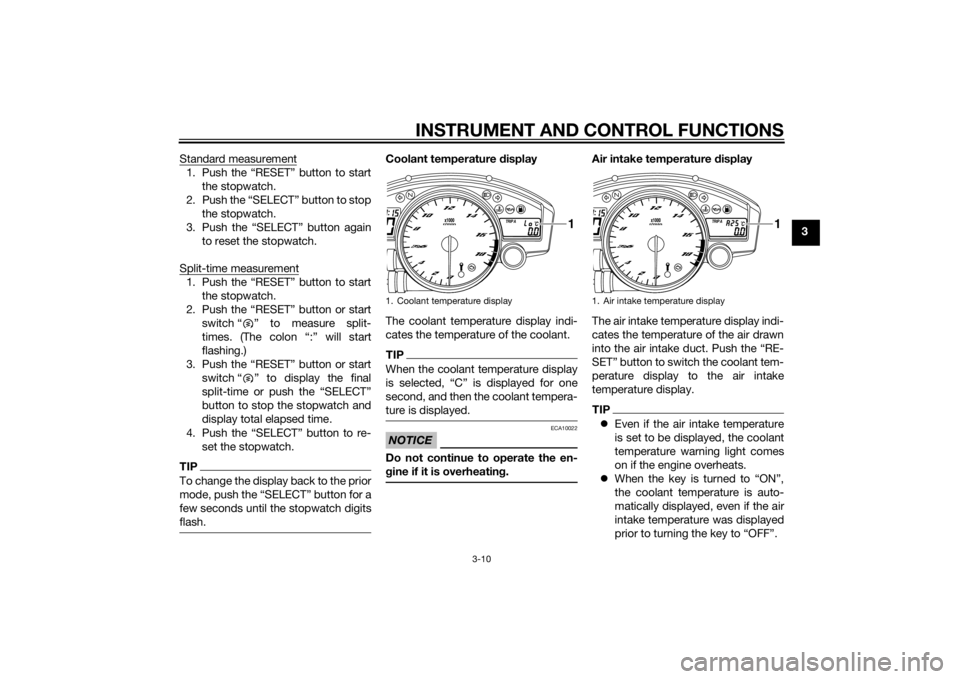
INSTRUMENT AND CONTROL FUNCTIONS
3-10
3
Standard measurement
1. Push the “RESET” button to start
the stopwatch.
2. Push the “SELECT” button to stop the stopwatch.
3. Push the “SELECT” button again to reset the stopwatch.
Split-time measurement1. Push the “RESET” button to start the stopwatch.
2. Push the “RESET” button or start switch “ ” to measure split-
times. (The colon “:” will start
flashing.)
3. Push the “RESET” button or start switch “ ” to display the final
split-time or push the “SELECT”
button to stop the stopwatch and
display total elapsed time.
4. Push the “SELECT” button to re- set the stopwatch.TIPTo change the display back to the prior
mode, push the “SELECT” button for a
few seconds until the stopwatch digits
flash.
Coolant temperature display
The coolant temperature display indi-
cates the temperature of the coolant.TIPWhen the coolant temperature display
is selected, “C” is displayed for one
second, and then the coolant tempera-
ture is displayed.NOTICE
ECA10022
Do not continue to operate the en-
g ine if it is overheatin g.
Air intake temperature display
The air intake temperature display indi-
cates the temperature of the air drawn
into the air intake duct. Push the “RE-
SET” button to switch the coolant tem-
perature display to the air intake
temperature display.TIP Even if the air intake temperature
is set to be displayed, the coolant
temperature warning light comes
on if the engine overheats.
When the key is turned to “ON”,
the coolant temperature is auto-
matically displayed, even if the air
intake temperature was displayed
prior to turning the key to “OFF”.
1. Coolant temperature display
TRIP A
˚C
1
1. Air intake temperature display
TRIP A
˚C
1
U2CXE0E0.book Page 10 Monday, July 29, 2013 2:02 PM
Page 45 of 112
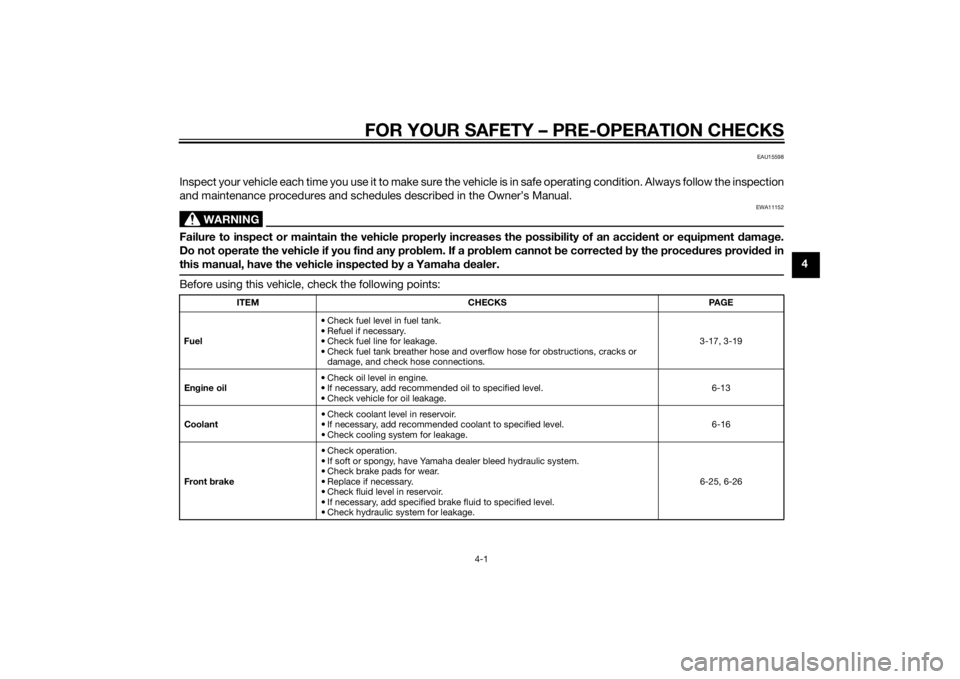
FOR YOUR SAFETY – PRE-OPERATION CHECKS
4-1
4
EAU15598
Inspect your vehicle each time you use it to make sure the vehicle is in safe operating condition. Always follow the inspection
and maintenance procedures and schedules described in the Owner’s Manual.
WARNING
EWA11152
Failure to inspect or maintain the vehicle properly increases the possibility of an acci dent or equipment damag e.
Do not operate the vehicle if you fin d any pro blem. If a pro blem cannot be corrected b y the proce dures provi ded in
this manual, have the vehicle inspecte d b y a Yamaha dealer.Before using this vehicle, check the following points:
ITEM CHECKS PAGE
Fuel • Check fuel level in fuel tank.
• Refuel if necessary.
• Check fuel line for leakage.
• Check fuel tank breather hose and overflow hose for obstructions, cracks or
damage, and check hose connections. 3-17, 3-19
En gine oil • Check oil level in engine.
• If necessary, add recommended oil to specified level.
• Check vehicle for oil leakage. 6-13
Coolant • Check coolant level in reservoir.
• If necessary, add recommended coolant to specified level.
• Check cooling system for leakage. 6-16
Front brake • Check operation.
• If soft or spongy, have Yamaha dealer bleed hydraulic system.
• Check brake pads for wear.
• Replace if necessary.
• Check fluid level in reservoir.
• If necessary, add specified brake fluid to specified level.
• Check hydraulic system for leakage. 6-25, 6-26
U2CXE0E0.book Page 1 Monday, July 29, 2013 2:02 PM
Page 48 of 112

OPERATION AND IMPORTANT RIDING POINTS
5-1
5
EAU15952
Read the Owner’s Manual carefully to
become familiar with all controls. If
there is a control or function you do not
understand, ask your Yamaha dealer.
WARNING
EWA10272
Failure to familiarize yourself with
the controls can lead to loss of con-
trol, which coul d cause an acci dent
or injury.
EAU46633
TIPThis model is equipped with: a lean angle sensor to stop the en-
gine in case of a turnover. In this
case, the multi-function display in-
dicates error code 30, but this is
not a malfunction. Turn the key to
“OFF” and then to “ON” to clear
the error code. Failing to do so will
prevent the engine from starting
even though the engine will crank
when pushing the start switch.
an engine auto-stop system. The
engine stops automatically if left
idling for 20 minutes. In this case,
the multi-function display indi-
cates error code 70, but this is not
a malfunction. Push the start
switch to clear the error code and
to restart the engine.
EAU33016
Startin g the en gineIn order for the ignition circuit cut-off
system to enable starting, one of the
following conditions must be met:
The transmission is in the neutral
position.
The transmission is in gear with
the clutch lever pulled and the
sidestand up.
See page 3-28 for more informa-
tion.
1. Turn the key to “ON” and make sure that the engine stop switch is
set to “ ”.
The following warning lights and
indicator lights should come on for
a few seconds, then go off. Oil level warning light
Fuel level warning light
Coolant temperature warning
light
Shift timing indicator light
Engine trouble warning light
Immobilizer system indicator
light
U2CXE0E0.book Page 1 Monday, July 29, 2013 2:02 PM
Page 67 of 112
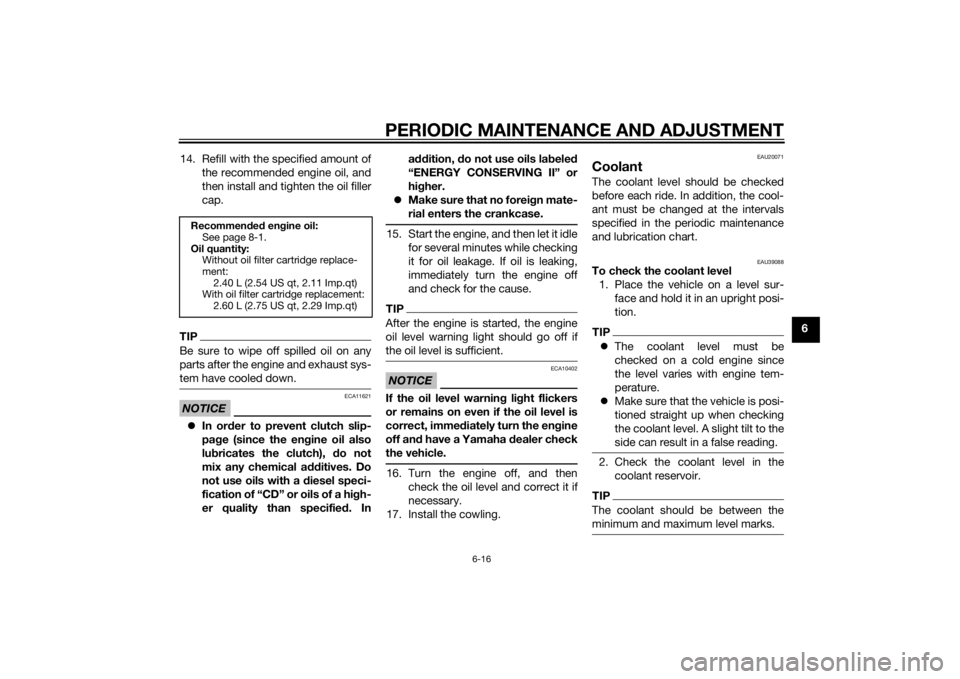
PERIODIC MAINTENANCE AND ADJUSTMENT
6-16
6
14. Refill with the specified amount of
the recommended engine oil, and
then install and tighten the oil filler
cap.
TIPBe sure to wipe off spilled oil on any
parts after the engine and exhaust sys-
tem have cooled down.NOTICE
ECA11621
In or der to prevent clutch slip-
pa ge (since the en gine oil also
lu bricates the clutch), do not
mix any chemical additives. Do
not use oils with a diesel speci-
fication of “CD” or oils of a hi gh-
er quality than specifie d. In a
dd ition, do not use oils lab eled
“ENERGY CONSERVING II” or
hi gher.
Make sure that no forei gn mate-
rial enters the crankcase.
15. Start the engine, and then let it idle for several minutes while checking
it for oil leakage. If oil is leaking,
immediately turn the engine off
and check for the cause.TIPAfter the engine is started, the engine
oil level warning light should go off if
the oil level is sufficient.NOTICE
ECA10402
If the oil level warnin g li ght flickers
or remains on even if the oil level is
correct, imme diately turn the en gine
off an d have a Yamaha dealer check
the vehicle.16. Turn the engine off, and then check the oil level and correct it if
necessary.
17. Install the cowling.
EAU20071
CoolantThe coolant level should be checked
before each ride. In addition, the cool-
ant must be changed at the intervals
specified in the periodic maintenance
and lubrication chart.
EAU39088
To check the coolant level 1. Place the vehicle on a level sur- face and hold it in an upright posi-
tion.TIPThe coolant level must be
checked on a cold engine since
the level varies with engine tem-
perature.
Make sure that the vehicle is posi-
tioned straight up when checking
the coolant level. A slight tilt to the
side can result in a false reading.2. Check the coolant level in the
coolant reservoir.TIPThe coolant should be between the
minimum and maximum level marks.
Recommen ded en gine oil:
See page 8-1.
Oil quantity: Without oil filter cartridge replace-
ment:2.40 L (2.54 US qt, 2.11 Imp.qt)
With oil filter cartridge replacement:
2.60 L (2.75 US qt, 2.29 Imp.qt)
U2CXE0E0.book Page 16 Monday, July 29, 2013 2:02 PM